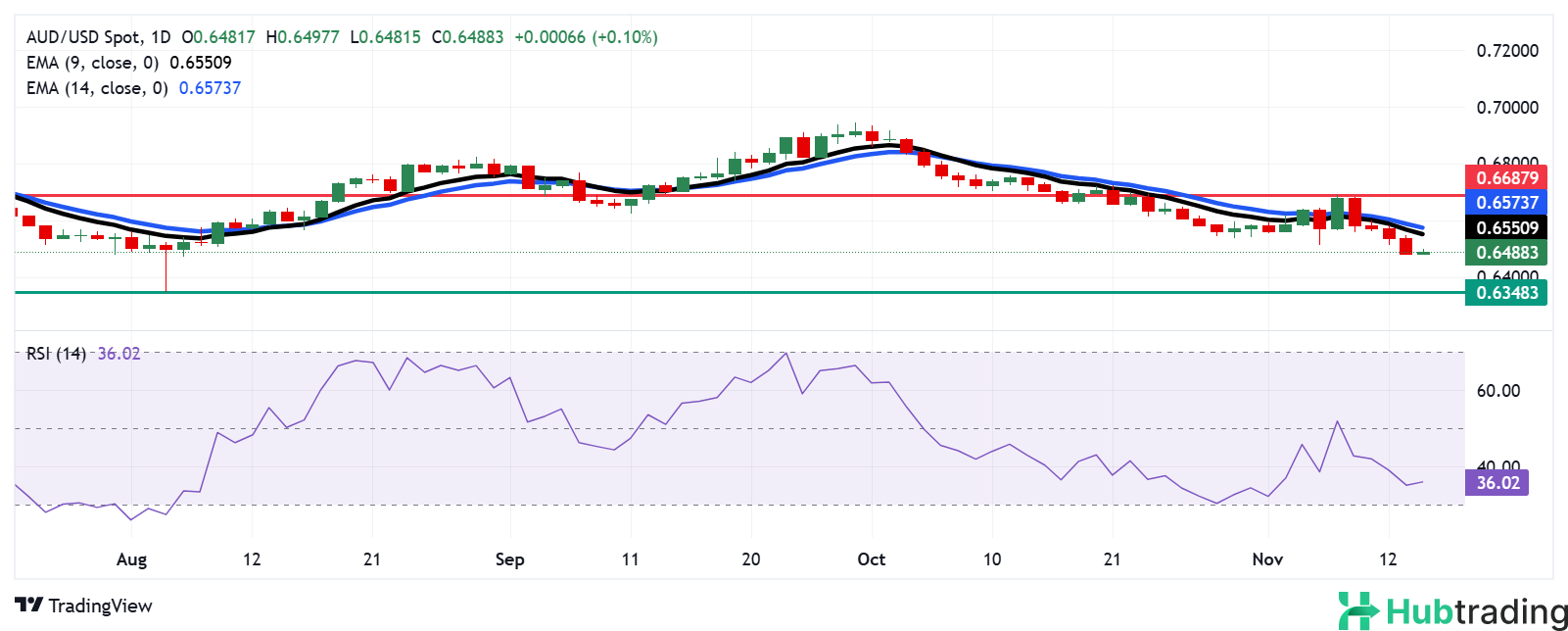- The Australian Dollar weakens despite hawkish remarks from RBA Governor Michele Bullock.
- Australia’s seasonally adjusted unemployment rate remained steady at 4.1% in October for the third consecutive month.
- Traders are now turning their attention to the U.S. Producer Price Index (PPI) data for October, due for release on Thursday.
The Australian Dollar (AUD) remains on a losing streak against the U.S. Dollar (USD) as recent economic data weigh on the currency. Australia’s Consumer Inflation Expectations fell to 3.8% in November, marking the lowest level since October 2021.
Meanwhile, RBA Governor Michele Bullock remarked that current interest rates are sufficiently restrictive and will remain so until inflation trends become more certain. She emphasized caution amid uncertainty regarding U.S. Federal Reserve policy.
The U.S. Dollar Index (DXY) hovers near 106.60, its highest point since November 2023, bolstered by post-election “Trump trades” and steady U.S. CPI data, as Trump’s recent election victory has fueled expectations of inflationary tariffs under his administration.
Australian Dollar Under Pressure as U.S. Dollar Gains Ground
- St. Louis Fed President Alberto Musalem commented on Wednesday that ongoing inflation challenges complicate the Fed’s ability to continue easing rates. He highlighted the strength of the U.S. labor market to reassure markets despite inflation’s resistance to Fed measures.
- Kansas City Fed President Jeffrey Schmid emphasized the difficulties in reducing interest rates further, cautioning market participants against unrealistic expectations for a return to near-zero rates.
- The U.S. Consumer Price Index (CPI) rose by 2.6% year-over-year in October, meeting forecasts, while core CPI, excluding food and energy, climbed by 3.3%, also in line with expectations.
- Australian Prime Minister Anthony Albanese disclosed in a recent radio interview that he discussed trade with U.S. President-elect Donald Trump, emphasizing the U.S. trade surplus with Australia and the importance of fair trade practices. Australia’s defense minister also noted the country’s significant security investments.
- According to Matthew Hassan, Senior Economist at Westpac, Australian consumers are increasingly confident in the economic outlook and less concerned about further interest rate increases, as pressures on family finances ease.
- China’s latest 10 trillion Yuan debt package, aimed at alleviating local government financing pressures, fell short of investor expectations as it avoided direct economic stimulus, dampening demand prospects for Australia’s largest trading partner and weighing on the Australian Dollar.
- A report from Morgan Stanley outlines three key areas of macroeconomic policy under the Trump administration: tariffs, immigration, and fiscal measures, with a focus on tariffs. The report anticipates a global tariff of 10% and a 60% tariff on China specifically.
- Fed Chair Jerome Powell remarked on Thursday that Trump’s potential return to the White House is not expected to impact near-term Fed policy. “We don’t guess, speculate, or make assumptions about future government policy,” Powell stated after the Fed’s decision to lower interest rates by 25 basis points to 4.50%-4.75%, as anticipated.
AUD/USD Trades Below 0.6500 Amid Short-Term Bearish Pressure
The AUD/USD pair trades around 0.6490 on Thursday. Technical analysis of the daily chart suggests short-term downward pressure, as the pair remains below the nine-day Exponential Moving Average (EMA), and the 14-day Relative Strength Index (RSI) remains below the 50 mark, supporting a bearish outlook.
The AUD/USD may find support near the psychological 0.6400 level; a break below could drive the pair toward the yearly low of 0.6348, last seen on August 5. On the upside, immediate resistance is seen at 0.6500, with further resistance at the nine-day EMA (0.6550) and the 14-day EMA (0.6573). A sustained move above these levels could push the pair toward its recent three-week high of 0.6687, with the next target at 0.6700.
AUD/USD: Daily Chart






